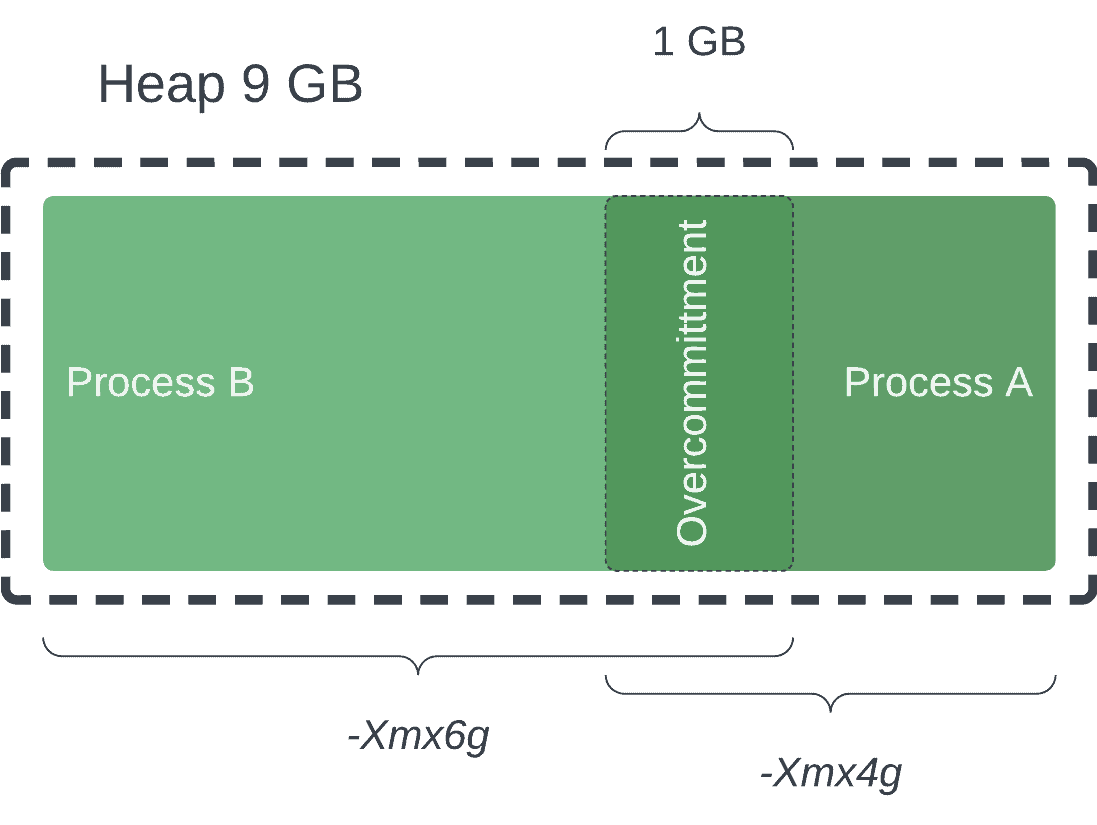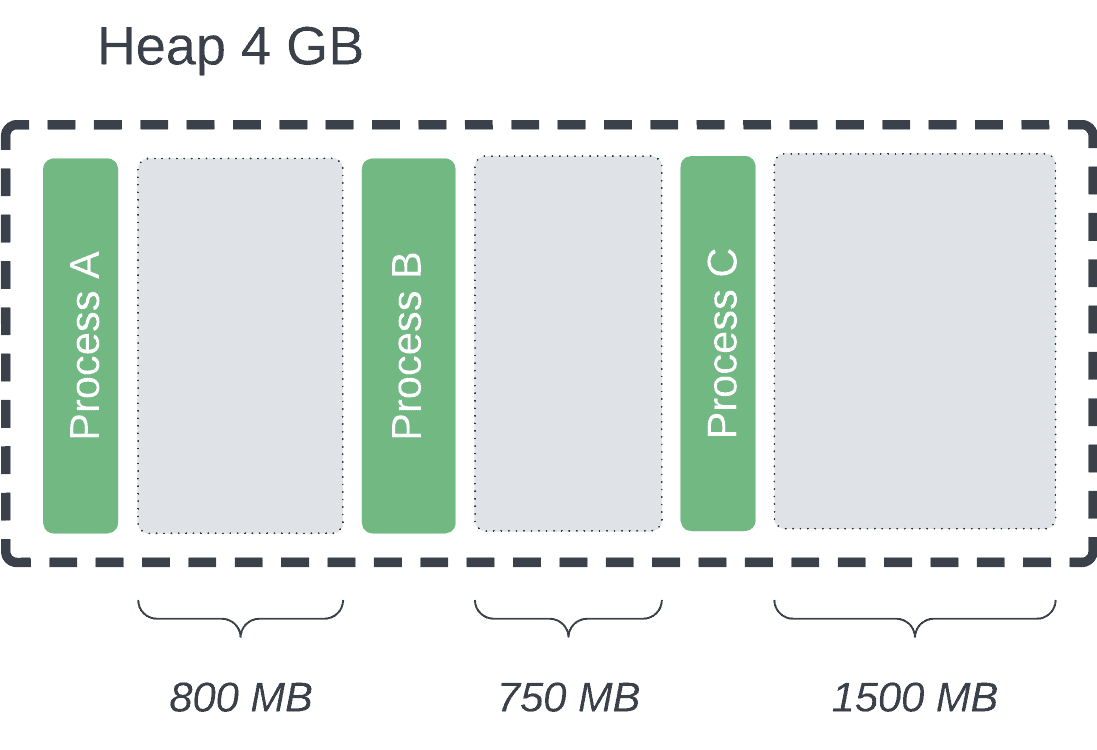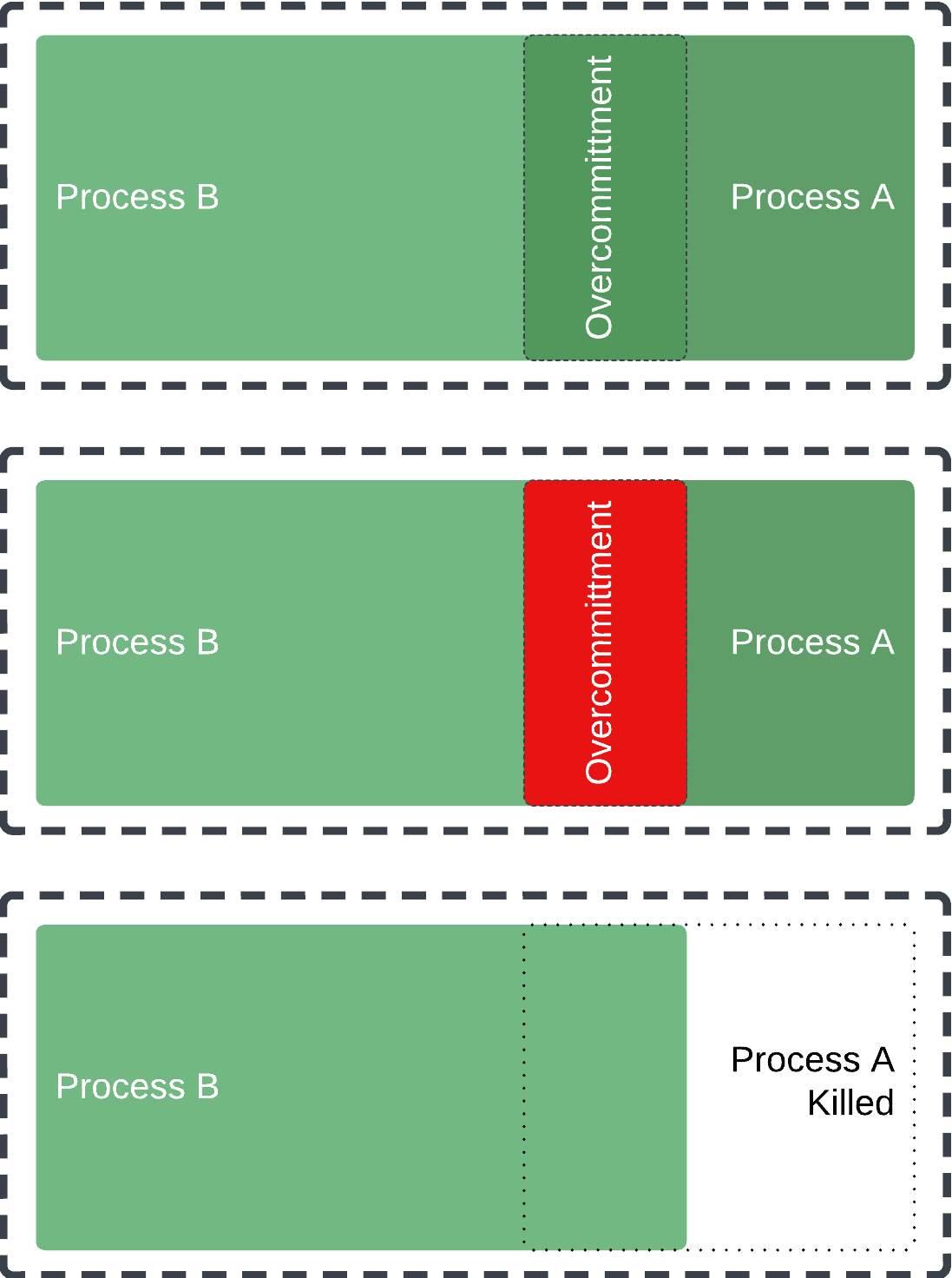2. -Xmx和-Xms参数
我们可以通过两个专门的JVM标志控制堆内存分配。-Xms用于设置堆的初始和最小大小,-Xmx则设置最大堆大小。虽然还有其他标志能实现更动态的分配,但整体功能类似。
这些参数与OutOfMemoryError的关系值得深究,它们既可能引发也可能避免该错误。首先明确一个基本原则:**-Xms不能大于-Xmx**。违反此规则会导致JVM启动失败:
$ java -Xms6g -Xmx4g
Error occurred during initialization of VM
Initial heap size set to a larger value than the maximum heap size
更有趣的场景是:当尝试分配超过物理内存的堆时会发生什么? 这取决于JVM版本、架构和操作系统等因素。例如Linux系统支持内存过量分配并可直接配置,而其他系统则依赖内部启发式算法:
即使物理内存充足,也可能因内存碎片导致启动失败。假设有4GB物理内存,其中3GB可用,分配2GB堆可能失败,因为RAM中没有足够大的连续空间:
较新的JVM版本可能没有这种限制,但仍可能影响运行时的对象分配。
3. 运行时OutOfMemoryError
即使应用成功启动,仍可能因多种原因遭遇OutOfMemoryError。
3.1. 堆空间耗尽
内存消耗增加可能源于正常业务场景(如节假日期间电商流量激增),也可能是内存泄漏导致。通过检查GC活动通常能区分这两种情况,但也可能存在更复杂场景,如终结延迟或GC线程性能低下。
3.2. 内存过量分配
交换空间的存在使内存过量分配成为可能。系统可通过将部分数据转储到磁盘来扩展RAM,这虽会导致性能显著下降,但能避免应用崩溃。不过这不是理想方案,极端情况下的内存颠簸甚至可能冻结系统。
内存过量分配类似于银行的 fractional reserve banking:RAM并未真正持有承诺给应用的所有内存。当应用开始索要承诺的内存时,操作系统可能终止次要应用以保障核心应用运行:
3.3. 堆内存收缩
此问题与过量分配相关,但根源在于GC的内存占用优化策略。即使应用在生命周期某刻成功占用了最大堆内存,也不保证下次能再次获得。
GC可能释放部分堆内存供系统重用,当应用尝试重新申请时,这些内存可能已被其他进程占用。
将-Xms和-Xmx设为相同值可避免堆收缩,使内存消耗更可预测,但可能降低资源利用率,需谨慎使用。不同JVM版本和GC的堆收缩行为也存在差异。
4. OutOfMemoryError类型
并非所有OutOfMemoryError都相同,了解其变体有助于定位根本原因。以下仅讨论与前述场景相关的类型:
4.1. Java heap space
日志显示:java.lang.OutOfMemoryError: Java heap space
这明确表示堆空间不足,可能由内存泄漏或负载激增导致,对象创建与回收速率失衡也可能引发此问题。
4.2. GC Overhead limit exceeded
错误信息:java.lang.OutOfMemoryError: GC Overhead limit exceeded
当应用98%时间都在执行GC(吞吐量仅2%)时触发,描述了GC颠簸状态:应用看似活跃但无实际产出。
4.3. Out of Swap Space
错误信息:java.lang.OutOfMemoryError: request size bytes for reason. Out of swap space?
这通常是操作系统层面内存过量分配的信号,此时堆仍有容量,但操作系统无法提供更多物理内存。
5. 根因分析
当OutOfMemoryError发生时,应用内能做的很有限。虽然不推荐捕获错误,但在某些场景下可用于清理或记录日志。⚠️ 避免使用try-catch处理业务逻辑,这是昂贵且不可靠的技巧。
5.1. 垃圾回收日志
OutOfMemoryError提供的信息有限,最简单的分析方法是启用GC日志,它开销小但能提供关键运行信息。
5.2. 堆转储
堆转储是另一种分析手段。定期捕获可能影响性能,最佳实践是在OutOfMemoryError发生时自动转储。通过-XX:+HeapDumpOnOutOfMemoryError启用,并用-XX:HeapDumpPath指定路径。
5.3. 错误触发脚本
使用-XX:OnOutOfMemoryError可指定内存耗尽时执行的脚本,适用于:
- 实现通知系统
- 发送堆转储到分析工具
- 重启应用
6. 总结
本文讨论了OutOfMemoryError及其外部成因。处理此类错误可能引发更严重问题并导致应用状态不一致,最佳策略是预防。
通过谨慎的内存管理和JVM配置可有效预防问题,分析GC日志有助于定位根因。✅ 在未理解根本原因前,盲目增加内存或使用保活技术并非良策,可能引发更多问题。


